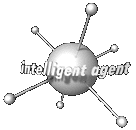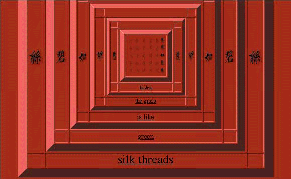
electronic books of creation


|
If you trust the press clips, "GRAMMATRON" marks the beginning of a new era: "a colosssal hypertext hydrogen bomb dropped on the literary landscape"--"the end of postmodernism and the beginning of Avant-Pop." "GRAMMATRON" is a narrative environment developed by virtual artist Mark Amerika in conjunction with the Brown University Graduate Creative Writing Program and the Graphics and Visualization Center of the National Science Foundation (NSF). Consisting of over 1000 text spaces, 1700 links, an original soundtrack delivered via RealAudio 3.0, as well as animated and still-life images, this hypermedia novel is competing with David Blair's Waxweb for the title of the most extensive narrative environment created for the Web. As the project description promises, future versions will integrate state-of-the-art Virtual Reality languages for a more immersive, collaborative experience ("Waxweb" is a collaborative environment).
"GRAMMATRON" addresses the idea of spirituality in the electronic age and comes with a companion theory-guide called "Hypertextual Consciousness." Needless to say that it's impossible to even try to summarize a hypertextual narrative as extensive as "GRAMMATRON" but some of the basic ideas may be described as follows: ever since the dawn of Man, forbidden data--called Nanoscript--were permeating the electrosphere. Nanoscript was the underlying code that transcribed the evolution of consciousness in a natural world. (As the hypertext tells us, this consciousness, originally thought to be the ultimate, state-of-the-art artificial intelligence, may actually be part of the language of desire; those familiar with the theories of Jacques Lacan or Julia Kristeva might have suspected it.) There is a Book of Creation but it has long since turned to dust out of which a creature has been molded. This creature--GRAMMATRON--has been encoded with the magic sorcerer-code called Nanoscript. Its unshaped mass of Digital Being contains all of the combinatory potential of all writing. GRAMMATRON (both the creature and the narrative environment it inhabits) aspires to be an electronic book of origins, a digital bible. Navigating the hypermedia environment may be an inspiring intellectual game, but it may be difficult for readers to get drawn in by the narrative and forget about all the levels of meta-hypertextuality. With all its combinatory potential, this mass of Digital Being is first and foremost a reflection on the creation of hypertextual narrative and consciousness. Readers assume the role of a decoder and--since what is supposedly encoded here is the evolution of consciousness itself--they may find themselves in a state of constant hyper-consciousness (which is probably the point).  Merel Mirage's "Poem Navigator.Compared to "GRAMMATRON," Merel Mirage's Poem Navigator seems to be a rather modest project--dedicated to decoding the origins of just one short Chinese poem. The history of the "Poem Navigator" is that of a casual encounter. According to the introduction to the project, Mirage was fascinated when she first heard the poem--words that offered no meaning to her beyond whimsical tones, unexpectedly changing their rhythms. She went to a Chinese restaurant in her neighborhood, and asked the cook about the poem. He told her that it was written in 754 AD by Li Po, a poet from the Tang dynasty, and wrote the characters down for her, with black ink on a white McDonalds napkin. At first disappointed to find that the poem was "just an ordinary love story," Mirage was fascinated by the symbols, each of which seemed to be a story in itself, and started a journey to the roots of the poem's characters. The "Poem Navigator" allows users to take this journey on their own. Visitors to the website find each line of the poem and its characters embedded in a frame-within-a-frame structure; they can explore the multiple meanings of the pictograms and the context for each line. The simple elegance of the navigator provides a perfect frame for the beauty of each of the Chinese characters enhancing their magic. Readers can unravel multiple layers of meaning, which gradually evolve into a fuller understanding of a tiny little piece of encoded meaning. For some readers, Li Po's little poem may ultimately turn out to be a more fascinating magic sorcerer-code than Nanoscript. |